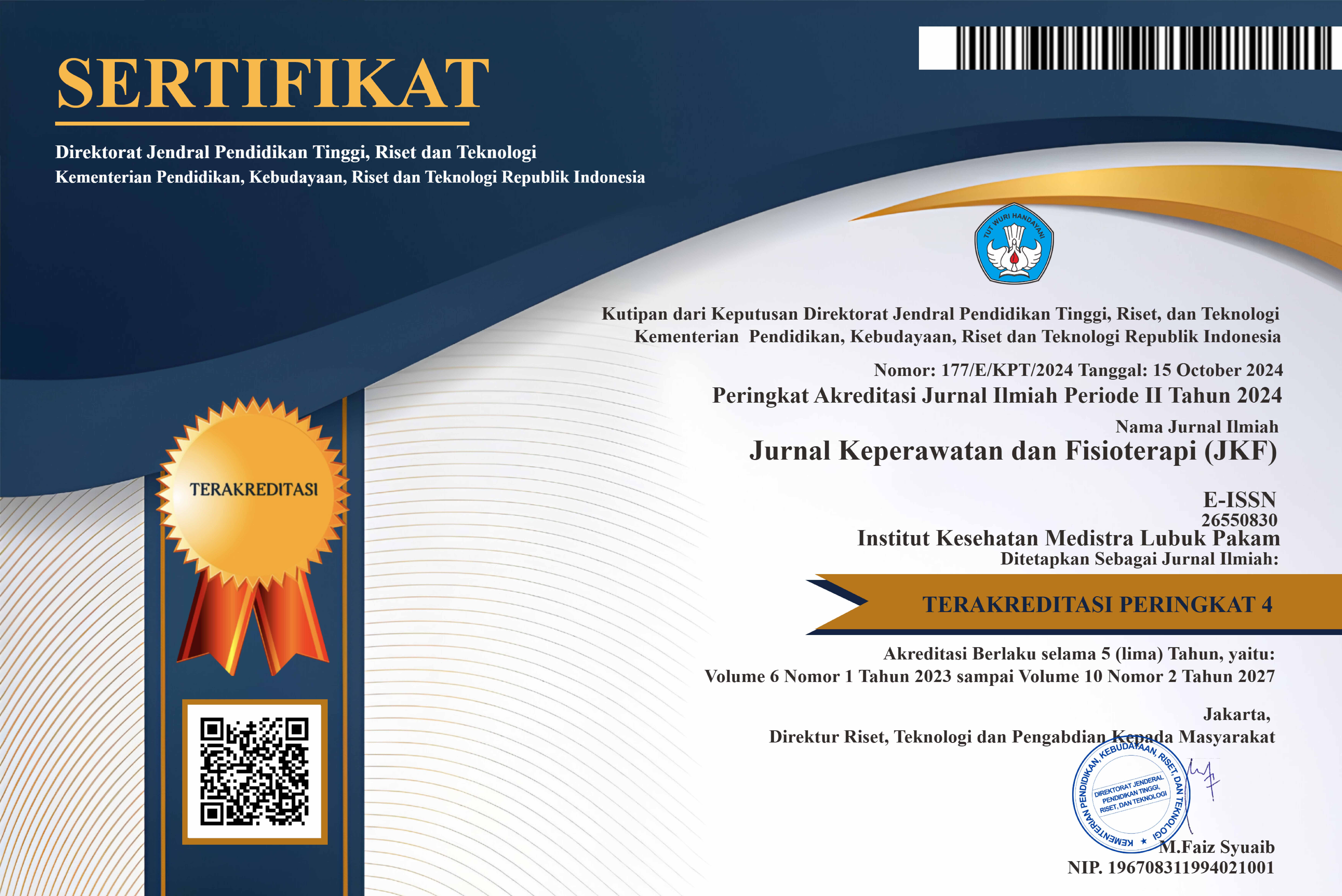KADAR VITAMIN DALAM PLASMA DARAH PADA PASIEN PSORIASIS DI KOTA MEDAN
DOI:
https://doi.org/10.35451/jkf.v2i1.182Keywords:
Vitamin D, Psoriasis, 25(OH)D levelAbstract
Psoriasis is a chronic inflammatory disease mediated by the immune system with a prevalence of 2-3% in the world population whose manifestations are found in the skin and other organs. Data on the prevalence of psoriasis is still diverse in several hospitals in Indonesia. Multifactors play a role in the incidence of psoriasis both genetic and environmental. Psoriasis lesions occur due to an imbalance between proliferation and differentiation of keratinocytes. Vitamin D has a role in regulating the balance of the process. Vitamin D is a fat soluble vitamin that can suppress the inflammatory process in psoriasis lesions.This study aimed to determine the frequency distribution of age, sex and levels of 25-Hydroxyvitamin D in blood plasma 44 psoriasis patients.Kadar vitamin D tersebut diukur menggunakan metode ELISA (DBC). The results obtained were the average age of 42-year-old psoriasis patients with the youngest age of 18 years and the oldest at 77 years. Female sex was 56.8% and men were 43.2%.The highest vitamin D level was 59.1 ng / ml and the lowest was 7.3 ng / ml so that it averaged 25.92 ng /ml. Analysis of vitamin D levels produced suficiency (31.8%), insufficiency (31.8%) and deficiency (36.4%).It can be concluded that vitamin D levels in psoriasis patients in Medan city 68.2% have less categories (<29 ng / ml) and most deficiencies at 48-57 years old.
Downloads
References
2. Barrea, L., Savanelli, M.C., Somma, C.D., Napolitano, M., Megna, M., Colao, A., Savastano, S. (2017). Vitamin D and Its Role in Psoriasis: An overview of the dermatologist and nutritionist. Rev Endocr Metab Disord (2017) 18:195–205 DOI 10.1007/s11154-017-9411-6
3. Boehncke, W.H. (2015). Etiology and Pathogenesis of Psoriasis. Rheum Dis Clin N Am :41 2015.665–675 http://dx.doi.org/10.1016/j.rdc.2015.07.013
4. Colotta, F., Jansson, B., Bonelli, F. (2017). Modulation of Inflammatory and immune responses by vitamin D. Journal of Autoimmunity 85 (2017) 78-97
5. Filoni, A., Vestita, M., Congedo, M., Giuduce, G., Tafuri, S., Bonamonte, D. (2018). Association between psoriasis and vitamin D: Duration of disease correlates with decreased vitamin D serum levels An observational case-control study. Medicine (2018) 97:25. http://dx.doi.org/10.1097.
6. Holick, M.F., Binkley, N.C., Bischoff-Ferrari, H.A., Gordon, C.M., Hanley, D.A., Heaney, R.P., Murad, M.H., Weaver, C.M. (2011). Evaluation, treatment, and prevention of vitamin D deficiency: an Endocrine Society Clinical Practice Guideline. Journal of Clinical Endocrinology and Metabolism; 1191–1930. (doi:10.1210/jc.2011-0385)
7. Kumari, B., Kumar, P., Chaudhary, R. K. P. (2017). Serum concentration of vitamin D in patients of psoriasis. Vol: 6. ISSN No 2277 – 8179. International Journal Of Scientific Research.
8. Langley, R.G.B., Krueger, G.G., Griffiths, C.E.M. (2005). Psoriasis: epidemiology, clinical features, and quality of life. Ann Rheum Dis; l64(Suppl II):ii18–ii23. doi: 10.1136/ard.2004.033217. Downloadedatwww.ard.bmj.com
9. Maleki, M., Nahidi, Y., Azizahari, S., Meibodi, N. T., Hadianfar, A. (2015). Serum 25-OH Vitamin D Level in Psoriatic Patients and Comparison With Control Subjects. Journal of Cutaneous Medicine and Surgery. DOI: 10.1177/1203475415622207
10.Mahajan, R & Handa, S. (2013). Pathophysiology of psoriasis. Indian Journal of Dermatology,Venereology, and Leprology, 79(7), 1. https://doi.org/10.4103/0378-6323.115505
11.Mosaad, Y.M., Mostafa, M., Elwasify, M., Youssef, H.M., Omar, N.M. (2017). Vitamin D and Immune System. Vitam Miner, 6:1. DOI: 10.4172/2376-1318.1000151
12Molina, J.O., Eisman, A.B., Polo, M.A., Ruiz, J. C., Santiago, S.A. (2012). Deficiency of serum concentration of 25-hydroxyvitamin D in psoriatic patients: A case control study. Journal American Academy of Dermatology. doi:10.1016/j.jaad.2012.01.040
13. Murray, R.K., Granner, D.K., Roadwell, V.W. (2012). Biokimia Harper. Edisi 27. EGC
14. Nayak, P. B., Girisha, B. S., Sripathi, H. Low Vitamin D in Psoriasis: Reality or Myth?. (2018). Indian J Dermatol. 2018 May-Jun; 63(3): 255–260.doi: 10.4103/ijd.IJD_35_18
15. Prietl, B., Treiber, G., Pieber, T.R., Amrein, K. (2013). Vitamin D and Immune Function. Nutrients 2013, 5, 2502-2521; doi:10.3390/nu5072502.
16. ramyothina, P dan Holick, M. F. (2012). Vitamin D supplementation: guidelines and evidence for subclinical deficiency. Curr O Opin Gastroenterol, 28:139–150 DOI:10.1097/MOG.0b013e32835004dc
17. Roy, S., Shrinivas, K., Bagchi, B. (2012). Vitamin D sensitivity to the immune responses and autoimmunity: A chemical network model study. SSCU, Indian Institute of Science, Bangalore 560012, India.
18. Soleymani, T., Hung, T., Soung, J. (2015). The role of vitamin D in psoriasis: a review.International Journal of Dermatology. doi: 10.1111/ijd.12790
19. Suhoyo, W. W., Tanjung, C., Nababan, K. A. (2013). Karakteristik pasien psoriasis di SMF Ilmu Kesehatan Kulit dan Kelamin Rumah Sakit Umum Pusat H. Adam Malik Medan periode Januari 2010-Desember 2012. Majalah Kedokteran Nusantara. April. Vol:46. No:1.
20. World Health Organization. Global Report on Psoriasis. (2016). Switzerland: World Health Organization Press.
Downloads
Published
Issue
Section
License
Copyright in each article is the property of the Author.


























